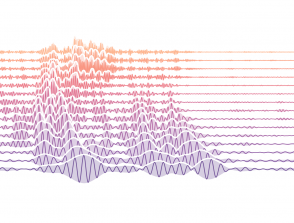Transport optimal entropique : applications dans le contexte de l’inversion de forme d’onde
Début : 01 septembre 2016
Fin : 17 décembre 2021
Encadrants :
Jean-Pierre Vilotte, Jean David Benamou
Équipes liées :
Sismologie
Statut : Soutenue
Seismic tomography aims at inferring physical properties and reconstructing quantitatively the “model”, i.e. structures of the Earth interior, from the mechanical waves – radiated by natural and man-made seismic sources – that are recorded at the surface by receivers in the form of seis-mograms. Over the past decades, Full-Waveform inversion (FWI) has been actively developed in both academia and industry, and has proven to be a powerful tool that dramatically improved the capability to estimate physical properties and structures of various geological targets from global to local scales. Full-waveform inversion (FWI) is formulated as a nonlinear, PDE-based optimisation problem that is classically solved by iterative minimisation of an objective function – measuring the misÿt bet-ween synthetic and observed seismic waveforms – using adjoint-based solution methods. Adjoint-based solution methods allow the computation of the derivative of the objective function with respect to the model parameters by combining the synthetic forward waveÿeld and an adjoint waveÿeld governed by a set of adjoint equations and adjoint subsidiary conditions. In practice, however, solving FWI problems using local, nonlinear optimisation methods is facing challenges that preclude routine use. The quality of the inversion, simultaneously dealing with long and short wavelengths information, is degraded by the lack of low frequencies and also depends on a good starting model. These limitations are linked to the ill-posed nature of the inverse problem which can be easily trapped into a local minimum. One proposed research direction to reduce the dependency on the initial model, is to replace the classical least-squares based misÿt by other objective functions – possibly involving nonlinear transformation of the seismic signal –hence promoting the convexity and trying to enlarge the basin of attraction of the global minimum. Optimal Transport (OT) theory has recently been use in inverse problems and machine learning. Optimal Transport lifts the properties of the squared Euclidean distance to the space of probability distributions. The optimal value (squared) of the transport itself deÿnes a distance called the 2-Wasserstein distance. This quantity is again convex but now on the set of probability distributions. This trend is already active for FWI, this thesis is part of it. The OT approach is still largely open on three fronts : Seismic Waveforms are not probability distributions, lacking positivity and nor-malised total mass. Convexity with respect to the model is not guaranteed and ÿnally the actual computation of the OT distance is not cheap. In this work we use and combine – from an academic point of view – two recent extensions of OT in the context of FWI. First the “unbalanced” OT distance, which rigorously deÿnes a distance on the set of positive Radon measure thus by-passing the data normalisation issue (but not the positivity problem). Then, the entropic regularisation OT framework and in particular the simple and easy to compute variant called Sinkhorn divergence providing a good approximation of the 2-Wasserstein distance. The Sinkhorn divergence can be naturally extended to unbalanced OT. We use these tools to construct and implement our unbalanced OT misÿt and discuss its use in the context of full-waveform inversion through a number of academic examples and classical benchmark problems






